Key Stamps on antique English flutes - survey request
- jemtheflute
- Posts: 6969
- Joined: Tue May 23, 2006 6:47 am
- antispam: No
- Please enter the next number in sequence: 8
- Location: N.E. Wales, G.B.
- Contact:
Key Stamps on antique English flutes - survey request
This topic crops up now and then. Terry McGee has a section on it on his website that hasn't really developed and the issue has been in my mind of late - not least last night when MarkP visited me with his anonymous Metzlerish flute (recently under discussion here) with some "AL" keys.
So.
This thread is to request that anyone with an antique keyed flute, especially English made, though not excluding other nationalities, examines the undersides of all their keys and, if possible, takes close-up photos of any stamps they find and posts them on this thread with a brief description of the flute - maker if any known and where from, approximate date if known, block or pillar mounted, timber, number of keys, metal (sterling silver or German Silver) which ones stamped (with what).
Let's see if we can build up a corpus of key stamps. Thanks in advance for any contributions. If you can't sort out photos, still have a look and post a written description, please. Remember to twist springs aside and look underneath them - I once told Terry my R&R had no key stamps and had neglected to do just that! I don't expect folk to go cutting away buffer corking to check though! If we miss any because they're hidden thus, that's just unfortunate.
Incidentally, I'm not really looking to include craftsmens' part numbering/job-tracing scratches and marks (very common on German made flutes, on wood as well as on the metal parts) - usually Roman numerals or simple oblique file marks like Ogham. By all means comment on them if they occur in conjunction with letter stamps, but they aren't what this thread is primarily about and in any case aren't so common on English flutes in my experience.
I'm sorting out my own contribution - post pending!
So.
This thread is to request that anyone with an antique keyed flute, especially English made, though not excluding other nationalities, examines the undersides of all their keys and, if possible, takes close-up photos of any stamps they find and posts them on this thread with a brief description of the flute - maker if any known and where from, approximate date if known, block or pillar mounted, timber, number of keys, metal (sterling silver or German Silver) which ones stamped (with what).
Let's see if we can build up a corpus of key stamps. Thanks in advance for any contributions. If you can't sort out photos, still have a look and post a written description, please. Remember to twist springs aside and look underneath them - I once told Terry my R&R had no key stamps and had neglected to do just that! I don't expect folk to go cutting away buffer corking to check though! If we miss any because they're hidden thus, that's just unfortunate.
Incidentally, I'm not really looking to include craftsmens' part numbering/job-tracing scratches and marks (very common on German made flutes, on wood as well as on the metal parts) - usually Roman numerals or simple oblique file marks like Ogham. By all means comment on them if they occur in conjunction with letter stamps, but they aren't what this thread is primarily about and in any case aren't so common on English flutes in my experience.
I'm sorting out my own contribution - post pending!
Last edited by jemtheflute on Tue Jun 16, 2009 9:43 am, edited 1 time in total.
I respect people's privilege to hold their beliefs, whatever those may be (within reason), but respect the beliefs themselves? You gotta be kidding!
My YouTube channel
My FB photo albums
Low Bb flute: 2 reels (audio)
Flute & Music Resources - helpsheet downloads
My YouTube channel
My FB photo albums
Low Bb flute: 2 reels (audio)
Flute & Music Resources - helpsheet downloads
- jemtheflute
- Posts: 6969
- Joined: Tue May 23, 2006 6:47 am
- antispam: No
- Please enter the next number in sequence: 8
- Location: N.E. Wales, G.B.
- Contact:
Re: Key Stamps on antique English flutes - survey request
Here goes.
My own Rudall & Rose #4683, London made c1843, cocus with sterling silver: stamps on Bb and G# touches under springs, appear to be a "J" elided (sharing the same main stem) with an "R" (perhaps for "John Rose"?), though I note from Terry's web-page these are most likely partial examples of the "RR" ones shown there, with only the serif of the foot of the first R showing.
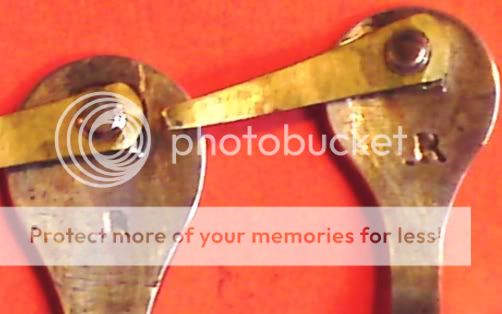
Wylde, "from Rudall & Rose", London c1840s, cocus with silver: stamped with an "F" on Bb and short F touches and x2 on low C# on touch and shank, which also has some job-marks (as does the low C, not shown). The long F is missing.
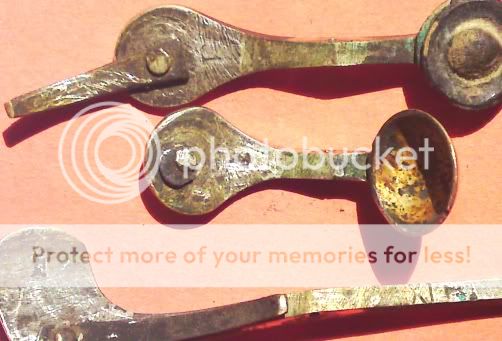
Eastes/J Fentum, stamped "Cambridge" but probably retailed there by Eastes, made in London by Fentum, c 1850s, cocus with silver: stamped "F" on Eb touch; stamped "H&I" on long F (very weak), low C# and Bb touches, maybe also on G# touch, though that is unclear - could be a botched "H&I" or just possibly "AL", though I think that unlikely - the apparent "A" is rally a composite of other tool marks/casting inconsistencies and perhaps part of the "H".
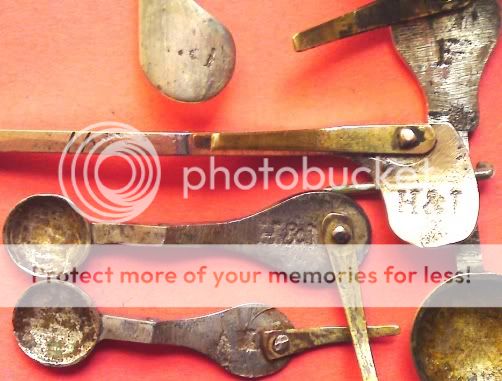
Metzler, London, probably 1850s-60s, cocus with German Silver: stamped "AL" on long C and Bb touches.
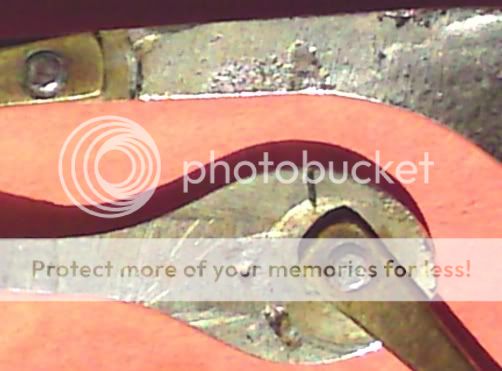
Anonymous English 8-key (my ref #51), unprovenanced, mid C19th, cocus with German Silver: stamped "F" on low C# touch.
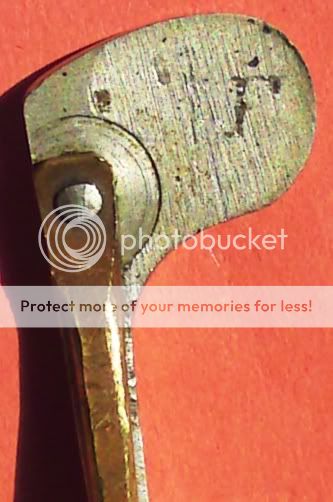
Anonymous English 4-key (my ref #56), unprovenanced, mid C19th, cocus with German Silver: stamped "I dot I" or possibly "[ dot ]" or even a vague square with central dot to all three extant keys (short F missing) - Bb, G# and Eb. These could well be weak examples of the "I dot N" or "I dot F" Terry illustrates. (Edit: actually, now I know I'm looking for it, I think I can just about make out the Ns in at least two of these, and more so in the photos than in reality. Ditto the first Rs on my R&R)
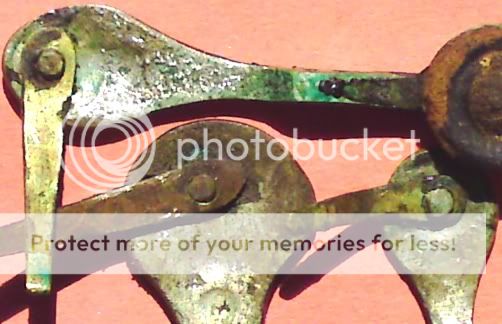
Manipulated close-ups of the Bb key trying to clarify the stamp:
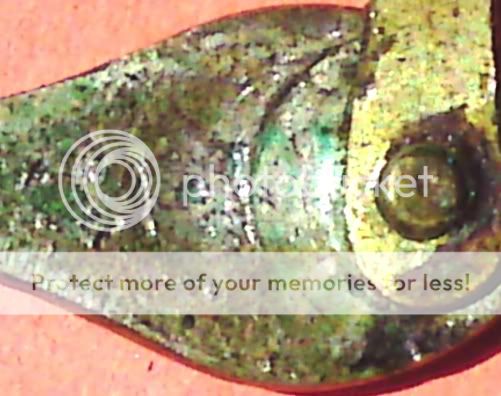
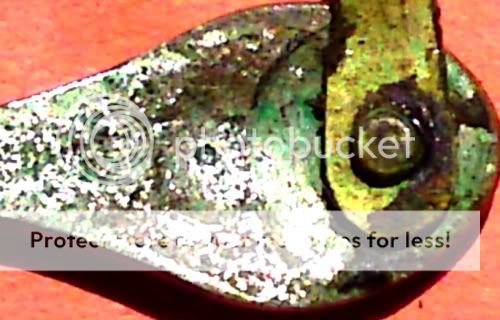
Anonymous English 8-key (my ref #59), unprovenanced (Metzler/Liddle style), mid C19th, cocus with German Silver: stamped "AL" on low C#, Eb, Bb and both long and short F keys.
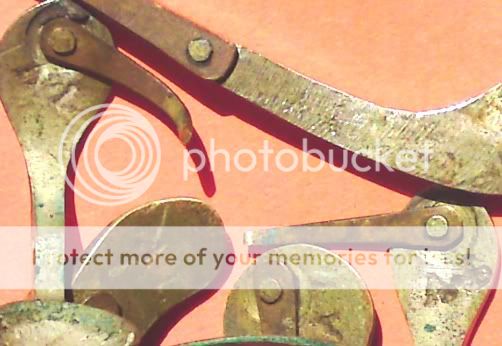
That's it for now. I have three other mid C19th English flutes here:- another anonymous Metzler style 8-key with Liddle style keys, but totally unstamped; another anonymous 8-key in a different style, also stampless; a Wolf & Figg (London) which has body stamps but no key markings. All are cocus with German Silver.
My own Rudall & Rose #4683, London made c1843, cocus with sterling silver: stamps on Bb and G# touches under springs, appear to be a "J" elided (sharing the same main stem) with an "R" (perhaps for "John Rose"?), though I note from Terry's web-page these are most likely partial examples of the "RR" ones shown there, with only the serif of the foot of the first R showing.

Wylde, "from Rudall & Rose", London c1840s, cocus with silver: stamped with an "F" on Bb and short F touches and x2 on low C# on touch and shank, which also has some job-marks (as does the low C, not shown). The long F is missing.

Eastes/J Fentum, stamped "Cambridge" but probably retailed there by Eastes, made in London by Fentum, c 1850s, cocus with silver: stamped "F" on Eb touch; stamped "H&I" on long F (very weak), low C# and Bb touches, maybe also on G# touch, though that is unclear - could be a botched "H&I" or just possibly "AL", though I think that unlikely - the apparent "A" is rally a composite of other tool marks/casting inconsistencies and perhaps part of the "H".

Metzler, London, probably 1850s-60s, cocus with German Silver: stamped "AL" on long C and Bb touches.

Anonymous English 8-key (my ref #51), unprovenanced, mid C19th, cocus with German Silver: stamped "F" on low C# touch.

Anonymous English 4-key (my ref #56), unprovenanced, mid C19th, cocus with German Silver: stamped "I dot I" or possibly "[ dot ]" or even a vague square with central dot to all three extant keys (short F missing) - Bb, G# and Eb. These could well be weak examples of the "I dot N" or "I dot F" Terry illustrates. (Edit: actually, now I know I'm looking for it, I think I can just about make out the Ns in at least two of these, and more so in the photos than in reality. Ditto the first Rs on my R&R)

Manipulated close-ups of the Bb key trying to clarify the stamp:


Anonymous English 8-key (my ref #59), unprovenanced (Metzler/Liddle style), mid C19th, cocus with German Silver: stamped "AL" on low C#, Eb, Bb and both long and short F keys.

That's it for now. I have three other mid C19th English flutes here:- another anonymous Metzler style 8-key with Liddle style keys, but totally unstamped; another anonymous 8-key in a different style, also stampless; a Wolf & Figg (London) which has body stamps but no key markings. All are cocus with German Silver.
Last edited by jemtheflute on Tue Jun 16, 2009 3:41 pm, edited 1 time in total.
I respect people's privilege to hold their beliefs, whatever those may be (within reason), but respect the beliefs themselves? You gotta be kidding!
My YouTube channel
My FB photo albums
Low Bb flute: 2 reels (audio)
Flute & Music Resources - helpsheet downloads
My YouTube channel
My FB photo albums
Low Bb flute: 2 reels (audio)
Flute & Music Resources - helpsheet downloads
- MarkP
- Posts: 859
- Joined: Tue Jun 26, 2007 5:49 am
- antispam: No
- Please enter the next number in sequence: 8
- Location: A long way from being an 'expert' at this
Re: Key Stamps on antique English flutes - survey request
So (as you know) we have an un-stamped Metzler(ish) 8 key, probably around 1850 with two keys stamped.
'AL' under the long Bb key, and 'F' under the low C# key


'AL' under the long Bb key, and 'F' under the low C# key


Last edited by MarkP on Thu Jun 18, 2009 3:02 pm, edited 2 times in total.
Mark
-
groxburgh
- Posts: 329
- Joined: Wed Nov 07, 2007 4:52 pm
- Please enter the next number in sequence: 1
- Location: Dunedin, New Zealand
Re: Key Stamps on antique English flutes - survey request
Of course this business of stamping marks under the keys is all very well but Monzani and Hill did it properly - on top for all to see. I don't have a photo of my own Monzani/Hill to hand but here's a couple of photos from Rick Wilson's website:
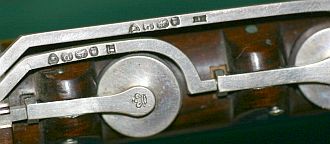
and close up

Cheers
Graeme

and close up

Cheers
Graeme
- jemtheflute
- Posts: 6969
- Joined: Tue May 23, 2006 6:47 am
- antispam: No
- Please enter the next number in sequence: 8
- Location: N.E. Wales, G.B.
- Contact:
Re: Key Stamps on antique English flutes - survey request
Thanks, Graeme, though proper silver hallmarks are another thing again, a bit like the job-marks. They convey the very useful information that hallmarks give, but don't tell us the same things as the (key-)maker stamps do - or may do when we understand them better. If there were maker stamps under the keys as well as hallmarks on top, that would add to the potentially deducible information. So far as I know (and I have no expertise on them) the official hallmarks per se do not denote a manufacturer, but s/he may add an unofficial identifying stamp/trade mark of their own. I think hallmarks give year dates by a letter code, related to a monarch's reign indicated by royal portrait and version of crest (or something along those lines), and a rough location by a stamp that represents a regional assay office that licensed the jeweller and another that indicates the metal type/quality, but nothing individual to a maker. There may be other info in them too.... I've no time now to go checking up.
I respect people's privilege to hold their beliefs, whatever those may be (within reason), but respect the beliefs themselves? You gotta be kidding!
My YouTube channel
My FB photo albums
Low Bb flute: 2 reels (audio)
Flute & Music Resources - helpsheet downloads
My YouTube channel
My FB photo albums
Low Bb flute: 2 reels (audio)
Flute & Music Resources - helpsheet downloads
-
groxburgh
- Posts: 329
- Joined: Wed Nov 07, 2007 4:52 pm
- Please enter the next number in sequence: 1
- Location: Dunedin, New Zealand
Re: Key Stamps on antique English flutes - survey request
But it does have the maker's mark on top. In this case HH for Henry Hill, as well as the date stamp etc.
Cheers
Graeme
Cheers
Graeme
- s1m0n
- Posts: 10069
- Joined: Wed Oct 06, 2004 12:17 am
- antispam: No
- Please enter the next number in sequence: 10
- Location: The Inside Passage
Re: Key Stamps on antique English flutes - survey request
AFAIK silver hallmarks indicate that the object is sterling, and identify the city/region* in which the silversmith was working and cycle through a twenty letter alphabetical sequence that indicates the date of manufacture. Every time the cycle gets around to A again, the typeface changes. You figure out the typeface, which gives you the start date, and then count up to your letter.jemtheflute wrote:Thanks, Graeme, though proper silver hallmarks are another thing again, a bit like the job-marks. They convey the very useful information that hallmarks give, but don't tell us the same things as the (key-)maker stamps do - or may do when we understand them better. If there were maker stamps under the keys as well as hallmarks on top, that would add to the potentially deducible information. So far as I know (and I have no expertise on them) the official hallmarks per se do not denote a manufacturer, but s/he may add an unofficial identifying stamp/trade mark of their own. I think hallmarks give year dates by a letter code, related to a monarch's reign indicated by royal portrait and version of crest (or something along those lines), and a rough location by a stamp that represents a regional assay office that licensed the jeweller and another that indicates the metal type/quality, but nothing individual to a maker. There may be other info in them too.... I've no time now to go checking up.
*the two I recall are London and York. London was a heraldic lion, which means a headshot of a cat-like beast facing the viewer, and York was a leopard. In heraldry a leopard is depicted in profile, and in this case it's the whole beastie, not just the head. If I'm remembering correctly, the other locations were Edinburgh (thistle) and Dublin (shamrock or maybe harp).
Finally, the third stamp was a crown which meant that the royal assay had seen and stamped the object. It's still illegal in the UK even to own a set of unauthorised punches.
And now there was no doubt that the trees were really moving - moving in and out through one another as if in a complicated country dance. ('And I suppose,' thought Lucy, 'when trees dance, it must be a very, very country dance indeed.')
C.S. Lewis
C.S. Lewis
- MarkP
- Posts: 859
- Joined: Tue Jun 26, 2007 5:49 am
- antispam: No
- Please enter the next number in sequence: 8
- Location: A long way from being an 'expert' at this
Re: Key Stamps on antique English flutes - survey request
I'm not an expert but from looking at other things in the past, Graeme's hallmarks could be as follows (correct me if I'm wrong)
Maker - could be the one on the left but it's hard to tell what it is
Duty - this should be the reigning monarch's head but it's difficult to make out and to reconcile with the others. It looks like the George III in 1784-6 but more likely Victoria from 1837 (could just possibly be the jubillee of George and Mary 1834-5). The others all face right anyway so it ought to be one of these.
Standard - lion passant implies Stirling .925 silver I think
Date - the 'P' (in this font style) denotes a date of 1750 or 1790 or 1830 (but see duty above)
City - the uncrowned leapard head was used in London from 1821/2 onwards
Maker - could be the one on the left but it's hard to tell what it is
Duty - this should be the reigning monarch's head but it's difficult to make out and to reconcile with the others. It looks like the George III in 1784-6 but more likely Victoria from 1837 (could just possibly be the jubillee of George and Mary 1834-5). The others all face right anyway so it ought to be one of these.
Standard - lion passant implies Stirling .925 silver I think
Date - the 'P' (in this font style) denotes a date of 1750 or 1790 or 1830 (but see duty above)
City - the uncrowned leapard head was used in London from 1821/2 onwards
Mark
-
groxburgh
- Posts: 329
- Joined: Wed Nov 07, 2007 4:52 pm
- Please enter the next number in sequence: 1
- Location: Dunedin, New Zealand
Re: Key Stamps on antique English flutes - survey request
Hi Mark
Yes all correct AFAIK. The makers mark is HH for Henry Hill, doesn't show up very well in the close up because it's side on (low C# key), but you can see it more clearly in the other photo on the low C key. The head is no clearer on my own Monzani/Hill flute that on those photos so I can't shed any more light on that.
The letter "p" implies the year would be 1830 - this is for a flute with serial number 3049. See http://www.oldflutes.com/articles/monzani.htm where these photos are coming from on Rick Wilsons website. My own Monzani/Hill has the letter "r" for 1832 but has a serial number 2450 = 599 earlier than Rick Wilsons one but hallmarked 2 years later. Seems to show that the keys / bodies were not made at the same time but in batches.
Cheers
Graeme
Yes all correct AFAIK. The makers mark is HH for Henry Hill, doesn't show up very well in the close up because it's side on (low C# key), but you can see it more clearly in the other photo on the low C key. The head is no clearer on my own Monzani/Hill flute that on those photos so I can't shed any more light on that.
The letter "p" implies the year would be 1830 - this is for a flute with serial number 3049. See http://www.oldflutes.com/articles/monzani.htm where these photos are coming from on Rick Wilsons website. My own Monzani/Hill has the letter "r" for 1832 but has a serial number 2450 = 599 earlier than Rick Wilsons one but hallmarked 2 years later. Seems to show that the keys / bodies were not made at the same time but in batches.
Cheers
Graeme
- jemtheflute
- Posts: 6969
- Joined: Tue May 23, 2006 6:47 am
- antispam: No
- Please enter the next number in sequence: 8
- Location: N.E. Wales, G.B.
- Contact:
Re: Key Stamps on antique English flutes - survey request
[THREAD REVIVAL - MOD]
I haven't made any additions to this for ages.... and some of what I'm adding now has at least been discussed elsewhere if not actually illustrated.
If anyone else cares to contribute, that's always welcome.
Terry, feel free to harvest and add any of this to your web-page on the topic. There are better pictures of the Wylde which I just did an odd shot of previously. Here's a link to the photobucket album all these images are hosted in.
Rudall & Rose #2130, (c 1831) - "RR" on G# key (only stamped key)


Rudall & Rose #4298 (c1841-2) - "RR" on Bb key and ?"I.N" (or is it a cruder "RR"?) on G# key.




Wylde from Rudall & Rose (my ref. #053) - "F" stamps on 3 keys and workshop numbers on 2 (incidentally, the 3 short keys on this flute are counter-sprung)



Butler 4-key (my ref. #086) - "A.L" stamps on all 4 keys, classic Liddle asymmetric Eb touch


Paine & Hopkins 9-key (B foot) concert flute #54 (Flute stamped "Paine & Hopkins, 69 Cornmill, London" - P&H were music publishers and flute dealers, not clear if actual makers, and at that address 1821-37) - "N" on long C key - only stamped key.


B&S Dulcet 8-key concert flute (My ref. #121) (Barnett Samuel - flute is in an associated but not provably original period case. The case can be dated to after 1876/7, which is consonant with the style of the flute.) - "F" stamps on long C and low C# keys and workshop numbers on the low C shank







I haven't made any additions to this for ages.... and some of what I'm adding now has at least been discussed elsewhere if not actually illustrated.
If anyone else cares to contribute, that's always welcome.
Terry, feel free to harvest and add any of this to your web-page on the topic. There are better pictures of the Wylde which I just did an odd shot of previously. Here's a link to the photobucket album all these images are hosted in.
Rudall & Rose #2130, (c 1831) - "RR" on G# key (only stamped key)


Rudall & Rose #4298 (c1841-2) - "RR" on Bb key and ?"I.N" (or is it a cruder "RR"?) on G# key.




Wylde from Rudall & Rose (my ref. #053) - "F" stamps on 3 keys and workshop numbers on 2 (incidentally, the 3 short keys on this flute are counter-sprung)



Butler 4-key (my ref. #086) - "A.L" stamps on all 4 keys, classic Liddle asymmetric Eb touch


Paine & Hopkins 9-key (B foot) concert flute #54 (Flute stamped "Paine & Hopkins, 69 Cornmill, London" - P&H were music publishers and flute dealers, not clear if actual makers, and at that address 1821-37) - "N" on long C key - only stamped key.


B&S Dulcet 8-key concert flute (My ref. #121) (Barnett Samuel - flute is in an associated but not provably original period case. The case can be dated to after 1876/7, which is consonant with the style of the flute.) - "F" stamps on long C and low C# keys and workshop numbers on the low C shank







I respect people's privilege to hold their beliefs, whatever those may be (within reason), but respect the beliefs themselves? You gotta be kidding!
My YouTube channel
My FB photo albums
Low Bb flute: 2 reels (audio)
Flute & Music Resources - helpsheet downloads
My YouTube channel
My FB photo albums
Low Bb flute: 2 reels (audio)
Flute & Music Resources - helpsheet downloads
- jemtheflute
- Posts: 6969
- Joined: Tue May 23, 2006 6:47 am
- antispam: No
- Please enter the next number in sequence: 8
- Location: N.E. Wales, G.B.
- Contact:
Re: Key Stamps on antique English flutes - survey request
PERIODIC REVIVAL
Here's a right old collection on another Fentum (stamped 29 Queen's Row, Walworth, London) - almost a full set! (cf the Eastes/Fentum up-thread - which has near-enough identical keys....)

"F" on the Bb and G#, "I.N" on the short F, "H&L" on the low C# and "///" workshop marks on the foot key shanks.
N.B. I think it is now clear that the "H&I" stamps i reprorted on the Eastes/Fentum must in fact be "H&L".
Here's a right old collection on another Fentum (stamped 29 Queen's Row, Walworth, London) - almost a full set! (cf the Eastes/Fentum up-thread - which has near-enough identical keys....)

"F" on the Bb and G#, "I.N" on the short F, "H&L" on the low C# and "///" workshop marks on the foot key shanks.
N.B. I think it is now clear that the "H&I" stamps i reprorted on the Eastes/Fentum must in fact be "H&L".
I respect people's privilege to hold their beliefs, whatever those may be (within reason), but respect the beliefs themselves? You gotta be kidding!
My YouTube channel
My FB photo albums
Low Bb flute: 2 reels (audio)
Flute & Music Resources - helpsheet downloads
My YouTube channel
My FB photo albums
Low Bb flute: 2 reels (audio)
Flute & Music Resources - helpsheet downloads
- jemtheflute
- Posts: 6969
- Joined: Tue May 23, 2006 6:47 am
- antispam: No
- Please enter the next number in sequence: 8
- Location: N.E. Wales, G.B.
- Contact:
Re: Key Stamps on antique English flutes - survey request
ANOTHER REVIVAL
I have just acquired the head/barrel and foot only (no body, alas) of a flute stamped "Simpson London" but with reminiscent of Hawkes/Pratten style foot keys - with nice clear "Wylde" stamps under them! I wouldn't be at all surprised if the missing body wasn't a one-piece one, maybe even one with Siccama keys given the projection of the touches/the short space between main pivot block and socket ring. The head has a small but excellent embouchure which plays very nicely on a couple of headless bodies I have - may well get married up with one of them! The style of the head and barrel and the crown cap and ball finial are very R&R/Wylde. So, yet more proof Wylde was contributing at least parts to "stencil" flutes for other makers and retailers.



I have just acquired the head/barrel and foot only (no body, alas) of a flute stamped "Simpson London" but with reminiscent of Hawkes/Pratten style foot keys - with nice clear "Wylde" stamps under them! I wouldn't be at all surprised if the missing body wasn't a one-piece one, maybe even one with Siccama keys given the projection of the touches/the short space between main pivot block and socket ring. The head has a small but excellent embouchure which plays very nicely on a couple of headless bodies I have - may well get married up with one of them! The style of the head and barrel and the crown cap and ball finial are very R&R/Wylde. So, yet more proof Wylde was contributing at least parts to "stencil" flutes for other makers and retailers.



I respect people's privilege to hold their beliefs, whatever those may be (within reason), but respect the beliefs themselves? You gotta be kidding!
My YouTube channel
My FB photo albums
Low Bb flute: 2 reels (audio)
Flute & Music Resources - helpsheet downloads
My YouTube channel
My FB photo albums
Low Bb flute: 2 reels (audio)
Flute & Music Resources - helpsheet downloads
- Jon C.
- Posts: 3526
- Joined: Wed Nov 07, 2001 6:00 pm
- antispam: No
- Please enter the next number in sequence: 8
- Tell us something.: I restore 19th century flutes, specializing in Rudall & Rose, and early American flutes. I occasionally make new flutes. Been at it for about 15 years.
- Location: San Diego
Re: Key Stamps on antique English flutes - survey request
If you think in the mindset of a flute manufacturer from the later part of the 19th century, flute makers were already looking to new designs, to compete with the cylindrical flutes introduced. I imagine most of the first generation makers like Henry Wylde, had long since hung up their gouges and reamer, passing the business to sons, or worthy employees. So it would reason that the makers of conical flutes became more consolidated, to only a couple of shops. If I was a flutest with. Flock of students or a musical instrument dealer, I would want to go to the manufacturer that was the most tried and true, Wylde... I could see their shop making a varity of models, because it wasn't so much the art form we see today, but a business.
So this would explain the flutes we have found like your Simpson, or the Bennett that had the twin that was stamped Rudall, Rose & Carte. I believe Robert Bigio had some documentation showing the dealers Wylde made flutes for?
I think we can all agree, the company did keep up their standard in good playing flutes, though the quality of the materials were sometime lacking, especially when he first established the company.
So this would explain the flutes we have found like your Simpson, or the Bennett that had the twin that was stamped Rudall, Rose & Carte. I believe Robert Bigio had some documentation showing the dealers Wylde made flutes for?
I think we can all agree, the company did keep up their standard in good playing flutes, though the quality of the materials were sometime lacking, especially when he first established the company.
"I love the flute because it's the one instrument in the world where you can feel your own breath. I can feel my breath with my fingers. It's as if I'm speaking from my soul..."
Michael Flatley
Jon
Michael Flatley
Jon
- tompipes
- Posts: 1328
- Joined: Wed Jan 28, 2004 12:50 am
- antispam: No
- Please enter the next number in sequence: 8
- Location: St. Louis via Dublin
- Contact:
Re: Key Stamps on antique English flutes - survey request
I had a quick look at my Fentum and there's H&L stamped on the C# key.
I'll take a closer look at the other keys tonight and take a few photos.
Tommy
I'll take a closer look at the other keys tonight and take a few photos.
Tommy